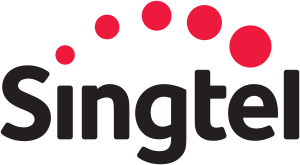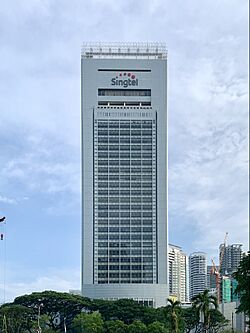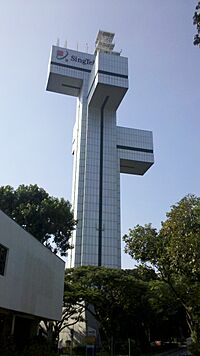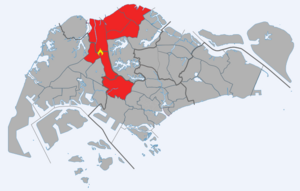Singtel facts for kids
 |
|

Comcentre, the corporate headquarters of Singtel
|
|
|
Trade name
|
Singtel |
|---|---|
| Public | |
| Traded as | SGX: Z74 |
| ISIN | ISIN: [https://isin.toolforge.org/?language=en&isin=US82929R3049 US82929R3049] |
| Industry | Telecommunications |
| Founded | 1879 (as Private Telephone Exchange) 28 March 1992 (as Singapore Telecom) |
| Headquarters | Comcentre,
,
Singapore
|
|
Area served
|
|
|
Key people
|
Yuen Kuan Moon (group CEO) |
| Products | Fixed-line and mobile telephony, broadband and fixed-line internet services, digital television, IT and network services |
| Revenue | |
|
Operating income
|
|
| Total assets | |
| Total equity | |
|
Number of employees
|
>25,000 |
| Parent | Temasek Holdings |
| Subsidiaries |
|
Singtel is a big company from Singapore. It provides many communication services. These include phone lines, mobile services, and internet. It is one of the main mobile phone companies in Singapore.
Singtel also owns parts of other communication companies. These are in countries like Australia and India. This makes Singtel a very large company in Asia.
Contents
About Singtel
Singtel is the biggest mobile phone company in Singapore. It has over 4 million customers there. When you add its other companies, it serves over 770 million mobile users. This makes it one of the largest in the world.
The company offers internet services, TV channels (Singtel TV), and mobile phone networks. It also provides regular home phone services. Singtel used to be called "Telecommunications Equipment" until 1995.
Singtel has grown a lot outside Singapore. It fully owns Optus, which is Australia's second-largest phone company. It also owns a part of Bharti Airtel, a big phone company in India.
In Singapore, Singtel has a large share of the market. It handles most of the fixed phone lines. It also has a big part of the mobile and internet markets. Singtel is one of the largest companies listed on the Singapore Stock Exchange. The Singapore government's investment company, Temasek Holdings, owns most of Singtel.
Singtel also invests in new technology companies. It does this through its company called Singtel Innov8. This company was started in 2011 to support new ideas.
Singtel's Journey Through Time
Early Beginnings: The 1800s
- 1883: Singapore's first phone network started. It was run by the Oriental Telephone and Electric Company (OTEC). They set up 60 phone lines for businesses.
Growing Up: The 1900s
- 1907: A new main phone exchange opened on Hill Street. It replaced the old OTEC system.
- 1955: The Singapore Telephone Board (STB) was created. It was the only company allowed to run phone services in Singapore.
- 1974: STB joined with the Telecommunications Authority of Singapore (TAS). Before this, STB handled local calls, and TAS handled international calls.
- 1982: The Postal Department also joined Singapore Telecom. This brought mail services under the same group.
- 1992: Singapore Telecommunications Private Limited (SingTel) became a separate company. The postal services became Singapore Post.
- 1993: SingTel became a public company. This meant people could buy shares in it on the stock market.
- 1997: SingTel received money from the government. This was because it lost its special right to be the only phone company earlier than planned.
The New Millennium: The 2000s
- 2000: SingTel's special right to be the only phone company in Singapore ended. Other companies could now offer phone services.
- 2001: SingTel got a license to offer 3G mobile services. In March, Singtel bought Optus, a large Australian phone company.
- 2003: SingTel sold its shares in Singapore Post. It also sold its Yellow Pages directory business. This helped Singtel focus on phone services.
- 2005: SingTel started offering 3G mobile services to its customers.
- 2007: Singtel launched its TV service, first called mio TV.
- 2008: SingTel was the first company to bring the iPhone 3G to Singapore.
- 2009: SingTel launched the iPhone 3GS in Singapore.
Expanding Services: 2011–2014
- 2011: SingTel planned to grow its satellite business. It aimed to launch two more satellites. SingTel also launched Skoob, Singapore's first e-book store.
- 2012: SingTel bought Amobee, a company that works with mobile advertising. SingTel also got the rights to show the 2012 Summer Olympics on its TV service.
- 2012: SingTel started offering 4G LTE services across Singapore.
- 2013: mio TV was officially renamed Singtel TV. SingTel sold its shares in Warid Telecom in Pakistan.
- 2014: SingTel joined with other global companies, including Google. They worked together to build a very fast undersea data cable. This cable connects the U.S. and Japan.
Modern Times: 2015–2019
- 2015: Singtel launched a new company look. This was its first change in 16 years. Singtel also bought Trustwave, a cybersecurity company in the US. Singtel released a new app called Wavee. It allowed users to make calls and send messages, similar to Skype or WhatsApp.
- 2017: Synack, a cybersecurity company, received investments from Microsoft, Hewlett Packard Enterprise, and Singtel.
- 2019: Singtel was recognized for its efforts in gender equality. Singtel partnered with NETSTARS. This allows travelers to use their home mobile payment apps in Japan.
Recent Developments: 2020–Present
- 2020: Singtel invested in a new gaming company called Storms. This was a joint effort with Thai and South Korean phone companies. Yuen Kuan Moon was appointed as the new group CEO of Singtel. Singtel and Grab were given a license to start a digital bank.
- 2024: Singtel introduced RE:AI. This is a cloud service designed to make AI technologies easy for businesses to use.
How Singtel Connects the World
Singtel has a large network of undersea cables. These cables connect Singapore to over 100 countries. Singtel is a big investor in many of these important cable systems. These include SEA-ME-WE 3, SEA-ME-WE 4, and Southern Cross Cable.
In 2010, Singtel joined a group to build the new SJC cable system. This cable started working in 2013. The SJC cable is about 8,900 km long. It links up to seven countries or areas. It connects with another cable system called Unity. This helps provide very fast internet between Asia and the US.
Singtel Mobile's 4G network covers almost all of Singapore. It has one of the best coverages in the country.
Singtel's Mobile Network in Singapore
Singtel uses different radio frequencies for its mobile network in Singapore. These frequencies help provide services like 4G LTE and 5G.
| Band | Frequency | Frequency Width (MHz) |
Protocol | Notes |
|---|---|---|---|---|
| 8 (900 MHz) | (905~915; 950~960) | 2x10 | HSPA+, LTE | |
| 28 (700 MHz) | (703~748; 758~803) | 2x20 | LTE, 5G NR | |
| 3 (1800 MHz) | (1710~1740; 1805~1835) | 2x30 | LTE | |
| 1 (2100 MHz) | (1935.1~1955.1; 2125.1~2145.1) | 2x20 | 5G NR | |
| 7 (2600 MHz) | (2540~2560; 2660~2680) | 2x20 | LTE | |
| 38 / 41 (2600 MHz) | 2600~2615 | 15 | LTE | |
| 78 (3.5 GHz) | 3450~3550 | 100 | 5G NR |
Companies in the Singtel Group
The Singtel group includes many companies. Some are fully owned, and others are partly owned. Most of its business is in mobile phones. The group has over 638 million mobile customers.
Regional Mobile Companies
Singtel has shares in many mobile companies across different countries.
| Country Mobile Share Data | |||||||||||
|---|---|---|---|---|---|---|---|---|---|---|---|
| Mobile company | Country | Stake | Market Position | as of 31 March 2023 | as of 31 March 2022 | as of 31 March 2021 | as of 31 March 2020 | as of 31 March 2019 | as of 30 June 2018 | as of 31 March 2017 | as of 31 March 2016 |
| Advanced Info Service | Thailand | 23% | No. 1 | 47.8% | 46% | 46% | 45.2% | 45% | 45% | 45% | 47% |
| Bharti Airtel | India | 32% | No. 2 | 32.4% | 31.6% | 29.8% | 28.4% | 28% | 31% | 23% | 24% |
| Globe Telecom | Philippines | 47% | No. 1 | 56.4% | 55.4% | 52.6% | 55% | 57% | 52% | 48% | 46% |
| Optus | Australia | 100% | No. 2 | 31.2% | 31.3% | 31.4% | (no data) | (no data) | 28% | 27% | 30% |
| Telkomsel | Indonesia | 30% | No. 1 | 49.1% | 53.6% | 58.7% | 59.3% | 51% | 50% | 48% | 30% |
Other Key Companies
- Singtel Mobile Singapore Pte Ltd: Provides mobile phone services in Singapore.
- Optus Mobile Pty Limited: Offers mobile phone services in Australia.
- NCS: Provides information technology and consulting services.
- Amobee: Works with mobile advertising.
- SingNet: Provides internet access and pay TV services.
- Singapore Post Limited: Handles postal and logistics services.
Important Events and Challenges
Bukit Panjang Exchange Fire
On October 9, 2013, a fire happened at a main Singtel internet building in Bukit Panjang. The fire caused many internet and phone services to stop working. This affected homes and businesses in the North Western parts of Singapore.
About 100 mobile phone towers were affected. This disconnected many mobile users. Also, tens of thousands of home internet lines, TV services, and voice lines stopped working. Other companies like StarHub and M1 also had problems because they used Singtel's network.
Singtel worked quickly to fix the damage. It took a few days to get most services back online. Singtel also offered ways for affected customers to get temporary internet. They also gave compensation to those affected.
An investigation found that the fire started during maintenance work. It was caused by an employee not following safety rules. Singtel made changes to its safety procedures to prevent this from happening again.
Marketing Campaign Issue
In March 2015, a blogger shared information about a marketing campaign. It showed that Singtel had worked with an agency to promote its services. The campaign involved asking bloggers to post negative comments about Singtel's competitors.
Singtel apologized to the other companies. It also ended its relationship with the marketing agency. Singtel stated that the employee involved did not follow the company's rules.
Data Security Incidents
- My Singtel App Data Issue: In February 2020, Singtel was fined for a data issue. During a system update, personal information of some mobile customers was accidentally exposed. A small number of customers' data was seen by others.
- Zero-day Attack: In February 2021, Singtel announced it had been attacked by hackers. This was a "zero-day attack," meaning it used a new weakness in a software system. The attack led to some customer data being stolen. This included names, contact numbers, and some bank details. Singtel apologized and worked to fix the problem.
- Volt Typhoon Attack: In June 2024, Singtel's systems were affected by a cyberattack from a group called Volt Typhoon. Singtel later announced that it had removed the harmful software from its systems.
Images for kids
See also
 In Spanish: Singapur Telecomunicaciones para niños
In Spanish: Singapur Telecomunicaciones para niños





